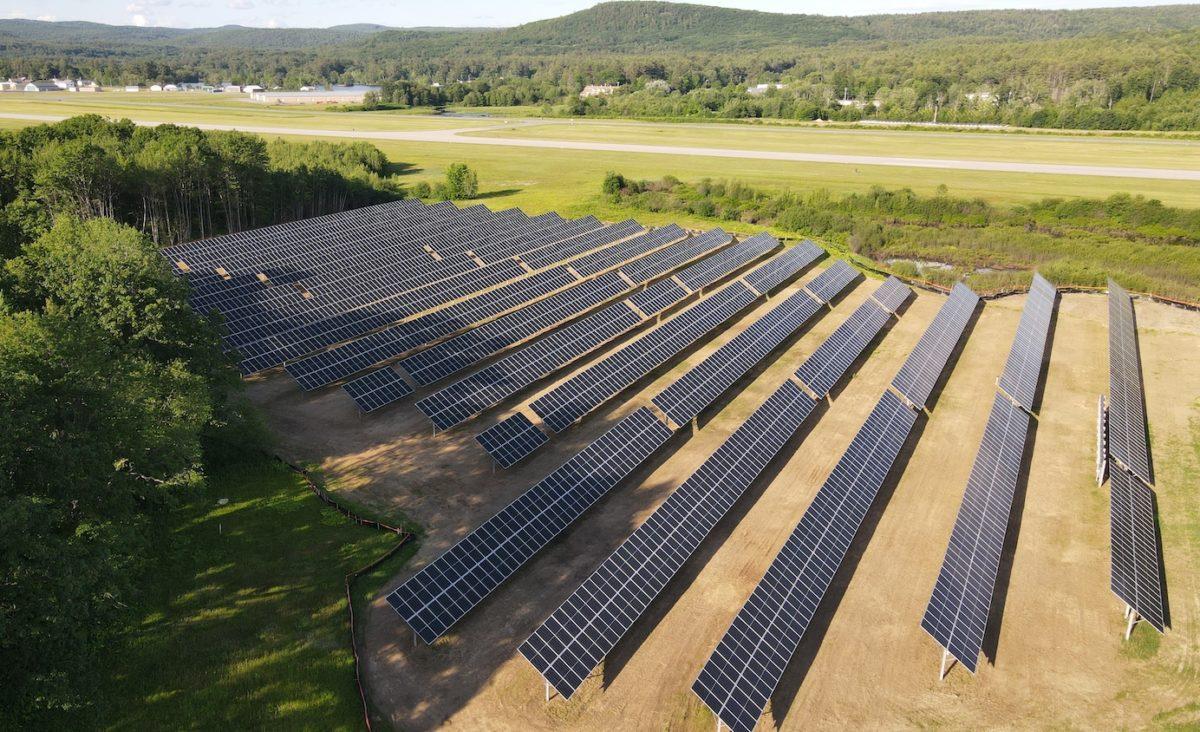City of Keene | Keene, NH
 By the numbers:
By the numbers:
System size: 2005 kW (5,594 solar panels)
System output: 2,440,30 kWh/year
CO₂ reduction: 2,393,965 pounds/year
The City of Keene is continuing to make significant strides toward its commitment to using 100% renewable energy by the year 2030, a resolution adopted by the Keene City Council in January of 2019. Most recently, the City celebrated a new 1.36 MW ground-mounted solar project located at the municipal Wastewater Treatment Plant and owned and operated by Ashuelot River Hydro, Inc.
When combined with the existing 643 kW solar array installed on the roof of the Keene Public Works and Police Departments, the City will generate an estimated 2.4 million kWh of clean, solar electricity each year—enough to offset a majority of the City’s total municipal electric needs. These solar arrays were both installed after competitive RFPs by ReVision Energy, a local employee-owned solar company. The new Wastewater Treatment Plant array will be Keene’s largest solar installation.
“The City of Keene Wastewater Treatment Plant is the largest single electricity user in Cheshire County,” states Duncan Watson, Assistant Public Works Director for the City. “The energy produced by the new array will offset the entire electric load and given the recent indications of a doubling of electric rates from Eversource, the economic benefit of the project is even better than our initial projections, not to mention the significant carbon reductions this project represents. The City team that evaluated this project and worked hard to make it a reality can be proud of their efforts.”
 Both projects were financed through Power Purchase Agreements (PPA) managed by ReVision Energy. The City of Keene paid no upfront fee to install the solar panels. Instead, local impact investors paid the upfront cost while the City pays for the power generated from the solar panels each month at a rate less than utility-provided power. After five years, the City may opt to buy the system from the investor at a reduced price and own all the solar power generated for the remainder of the 25-year warranty period and 40-year commercial lifespan. The new 1.36 MW solar farm at the Wastewater Treatment Plant was financed by Ashuelot River Hydro Inc, a diversified clean energy provider headquartered in Keene.
Both projects were financed through Power Purchase Agreements (PPA) managed by ReVision Energy. The City of Keene paid no upfront fee to install the solar panels. Instead, local impact investors paid the upfront cost while the City pays for the power generated from the solar panels each month at a rate less than utility-provided power. After five years, the City may opt to buy the system from the investor at a reduced price and own all the solar power generated for the remainder of the 25-year warranty period and 40-year commercial lifespan. The new 1.36 MW solar farm at the Wastewater Treatment Plant was financed by Ashuelot River Hydro Inc, a diversified clean energy provider headquartered in Keene.
“As a longtime resident of Keene, I’m proud to see our city take the lead in harnessing both water and sun to meet a growing share of our energy needs,” says Bob King, president of Ashuelot River Hydro. “With heat waves, floods and hurricanes imposing ever higher tolls and with the cost of fossil fuels going through the roof, Keene is proving that we can power a clean and sustainable future with abundant homegrown renewables like solar.”
Dozens of local electricians, electrical apprentices, engineers, and other solar professionals were employed in the development and construction of the new solar array, which began with a municipal RFP in 2019. Like the Keene Public Works and Police Department array, the new solar project will be maintained by ReVision Energy’s in-house electricians for the duration of the Power Purchase Agreement, and longer if the owner so chooses.
“ReVision Energy is honored to continue our partnership with the City of Keene, a municipal leader in New Hampshire’s clean energy transition,” says Dan Weeks, Vice President of Business Development at ReVision Energy. “This landmark solar project demonstrates both fiscal and environmental responsibility and will inspire other communities to become energy self-sufficient in the face of rising energy costs.”
Here is how the total project breaks down:
City of Keene – Keene, New Hampshire:
-
Roof of Public Works Department and Keene Police Department (350-400 Marlboro Street)
-
System size: 643.2 kilowatts (2010 solar panels)
-
System output: 738,779 kilowatt-hours/year
-
CO₂ reduction: 724,742 pounds/year
Ground Mount next to Waste Water Treatment Plant:
-
System size: 1361.9 kilowatts (3584 solar panels)
-
System output: 1701552 kilowatt-hours/year
-
CO₂ reduction: 1669223 pounds/year
